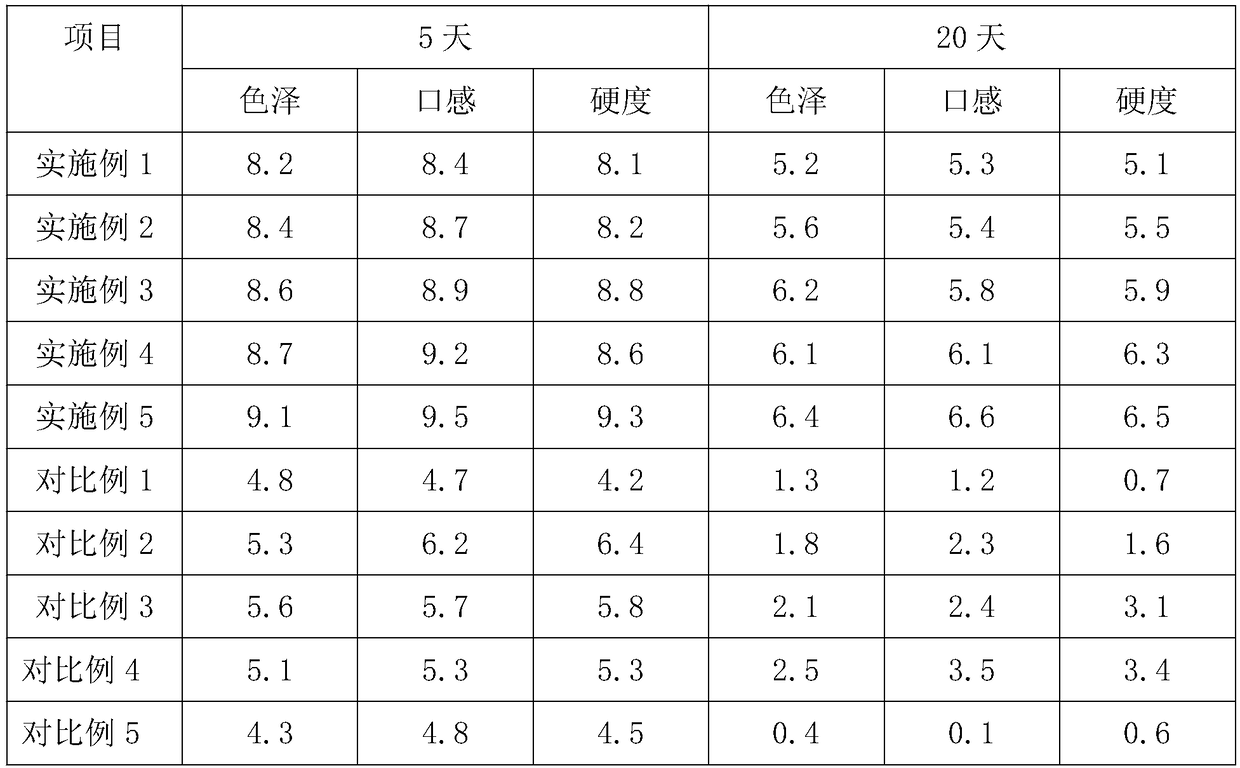Edible fungus preservation solution and preparation method thereof
A technology of fresh-keeping liquid and edible fungi, which is applied in the field of edible mushroom fresh-keeping liquid and its preparation, can solve the problem of no browning phenomenon treatment, etc., achieve the effects of preventing browning and bacterial infection, strong fresh-keeping ability, and prolonging the fresh-keeping period
- Summary
- Abstract
- Description
- Claims
- Application Information
AI Technical Summary
Problems solved by technology
Method used
Image
Examples
Embodiment 1
[0031] This embodiment relates to a fresh-keeping solution for edible fungi, which includes the following raw materials in parts by weight: 40 parts of kelp, 38 parts of sage, 28 parts of konjac extract, 22 parts of isatidis, 12 parts of lemon, 20 parts of honeysuckle, and 8 parts of Viola chinensis 1 part, 6 parts of chitosan, 3 parts of sodium sulfite, 1 part of calcium propionate, 2 parts of sodium phosphate, and 1 part of naphthaleneacetic acid.
[0032] Wherein, the particle size of the calcium propionate and sodium phosphate is 80 mesh.
[0033] Wherein, the preparation method of the konjac extract is as follows: take fresh konjac and put it into a grinder to grind it to a particle size of 300 mesh, add cellulase, put it in an insulated tank, control the temperature at 27° C., and keep it for 35 minutes. Then add water with 4 times the weight of fresh konjac, keep it warm for 2 hours at a temperature of 50° C., use an ultrasonic oscillator to vibrate at the same time, an...
Embodiment 2
[0041] This embodiment relates to a fresh-keeping solution for edible fungi, which includes the following raw materials in parts by weight: 58 parts of kelp, 46 parts of sage, 40 parts of konjac extract, 34 parts of isatidis, 22 parts of lemon, 28 parts of honeysuckle, and 16 parts of Viola chinensis 14 parts of chitosan, 9 parts of sodium sulfite, 5 parts of calcium propionate, 5 parts of sodium phosphate, and 3 parts of naphthaleneacetic acid.
[0042] Wherein, the particle size of the calcium propionate and sodium phosphate is 200 mesh.
[0043]Wherein, the preparation method of the konjac extract is as follows: take fresh konjac and put it into a grinder and grind it until its particle size is 500 mesh, add cellulase, put it in an insulated tank, control the temperature at 30 ° C, and keep it for 50 minutes. Then add water with 6 times the weight of fresh konjac, keep it warm for 4 hours at a temperature of 60° C., use an ultrasonic oscillator to vibrate at the same time, ...
Embodiment 3
[0051] This embodiment relates to a fresh-keeping solution for edible fungi, which includes the following raw materials in parts by weight: 42 parts of kelp, 40 parts of sage, 30 parts of konjac extract, 24 parts of isatidis, 14 parts of lemon, 22 parts of honeysuckle, and 10 parts of Viola chinensis. 8 parts, chitosan 8 parts, sodium sulfite 5 parts, calcium propionate 2 parts, sodium phosphate 3 parts, naphthalene acetic acid 1 part.
[0052] Wherein, the particle size of the calcium propionate and sodium phosphate is 80 mesh.
[0053] Wherein, the preparation method of the konjac extract is as follows: take fresh konjac and put it into a grinder to grind it to a particle size of 300 mesh, add cellulase, put it in an insulated tank, control the temperature at 27° C., and keep it for 35 minutes. Then add water with 4 times the weight of fresh konjac, keep it warm for 2 hours at a temperature of 50° C., use an ultrasonic oscillator to vibrate at the same time, and obtain konja...
PUM
 Login to View More
Login to View More Abstract
Description
Claims
Application Information
 Login to View More
Login to View More - R&D
- Intellectual Property
- Life Sciences
- Materials
- Tech Scout
- Unparalleled Data Quality
- Higher Quality Content
- 60% Fewer Hallucinations
Browse by: Latest US Patents, China's latest patents, Technical Efficacy Thesaurus, Application Domain, Technology Topic, Popular Technical Reports.
© 2025 PatSnap. All rights reserved.Legal|Privacy policy|Modern Slavery Act Transparency Statement|Sitemap|About US| Contact US: help@patsnap.com

